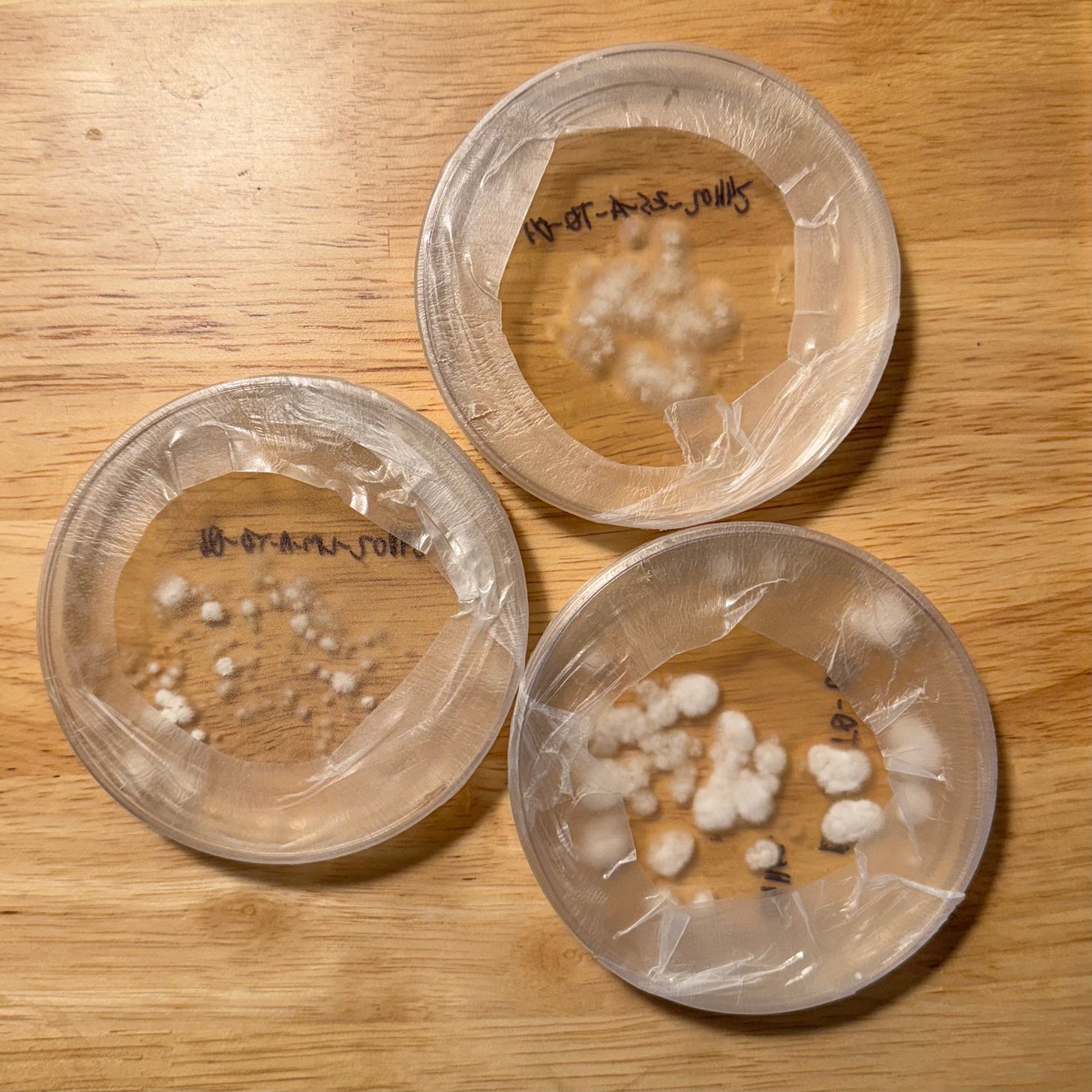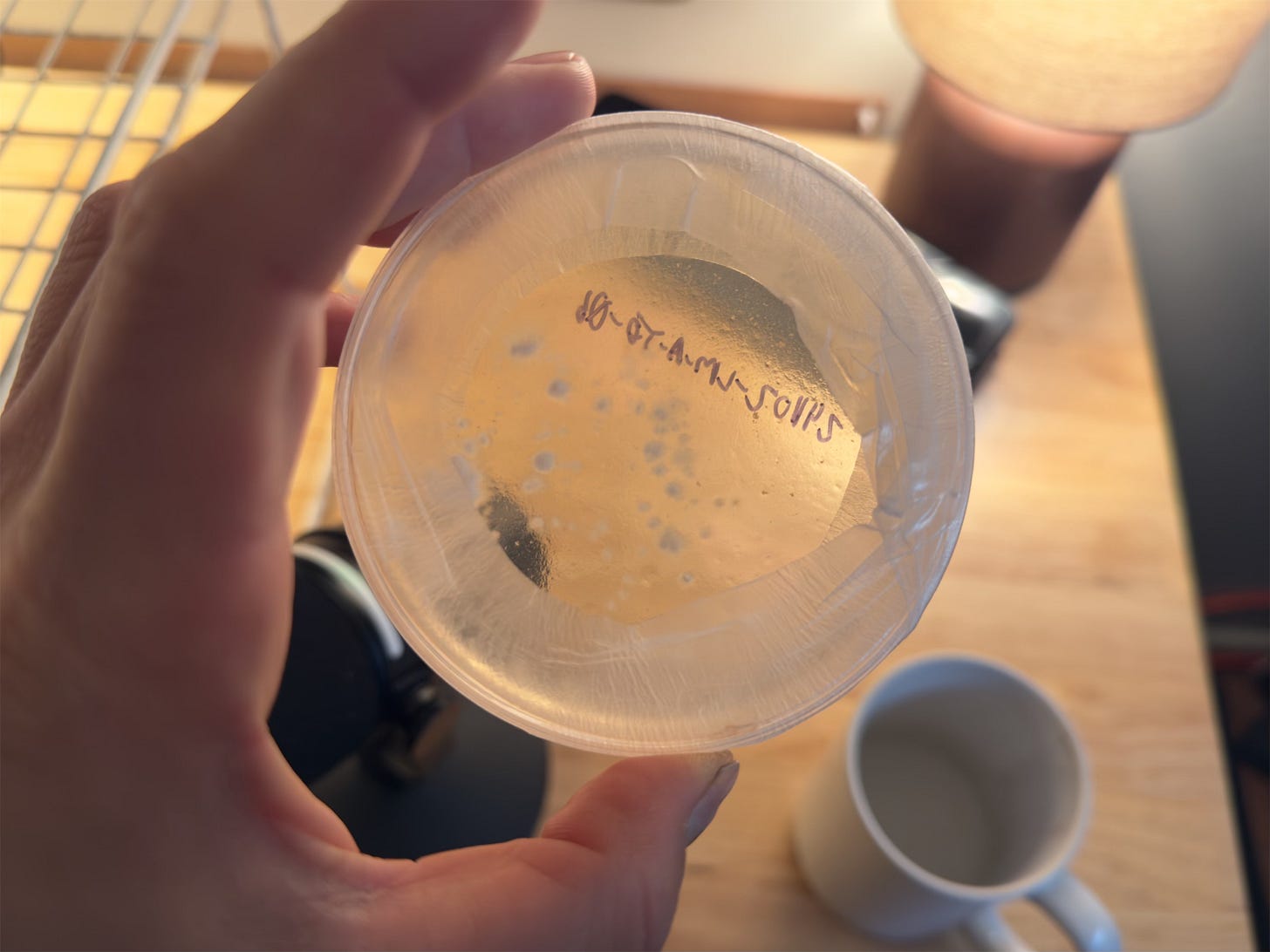First Round of Agar Plates
After years of waiting, I'm finally going to grow mushrooms the right way!
After two years of relying on mushroom liquid cultures with only the occasional use of agar plates, I decided to focus exclusively on agar plate work for growing mushrooms this winter. There are several long-term advantages to using agar plates instead of syringes when scaling up your mushroom growing operation:
You can identify, isolate, and propagate the most vigorous cultures by easily comparing the growth rates of different samples. Once you spot fast-growing cultures, you can cut out a section and transfer it to a new plate for further propagation.
This isolation method also protects strong cultures from contaminants. In liquid cultures, it's impossible to separate contaminants from the mushroom culture. However, on an agar plate's flat surface, I can easily cut out a healthy piece of mycelium and transfer it away from any contamination.
I can transfer strong cultures to slants, which effectively preserve the culture for years instead of just months like liquid cultures. This allows me to maintain a consistently excellent culture that I can use indefinitely.
The reduced contamination rates of agar plates help save on materials and costs. It's depressing to discard a perfectly sterilized jar of millet due to contamination from a liquid culture syringe—especially knowing it could have been prevented!
At Badwater Mushrooms, our growing operation’s leading objective is to find mushroom growing methods that minimize plastic and material waste. Agar seems to be a step in the right direction.
Considerations for Liquid Cultures versus Agar Plates
It’s important to note what we’re losing by switching from liquid cultures, because when LCs work, they work. We are losing the ability to have a highly transportable medium for mushroom cultures that, under the right conditions, remove the need for a completely sterile environment.
Consider how liquid culture syringes and grain spawn bags or jars function together. You have two sterile environments for your mushroom growing media, and the needle can transfer between the syringe and the bag or jar without exposure to external contaminants. This beginner growers benefit from this process by staying completely isolated from environmental factors when making a critical transfer.
In contrast, agar plates maintain sterility by remaining sealed. However, each time you open the lid, you risk introducing contaminants. When a single plate can potentially yield 15+ transfers to other plates or grain spawn, you’ve opened up a can of worms that requires more advanced sterility techniques to prevent contamination.
It’s apparent that beginners to grow process should try using liquid culture syringes in the beginning, just so they can understand how the process works, and see mycelial growth in all its phases. But once you want to graduate to a process that aims to minimize waste and maximize mycelial growth, you will want to move on to agar plates.
The First Round
I had a large collection of old liquid cultures that I had left in my fridge for six months. I knew these cultures would be weak and susceptible to contamination. Rather than wasting time and resources by directly inoculating grain jars with these old cultures and hoping for the best, I decided to transfer them onto agar plates.
This approach would allow me to assess whether the cultures were still viable and, if so, identify any contaminants they might be living with.
I transferred eight different cultures onto 36 dishes. Most cultures were spread across four plates each, while Lion's Mane—my primary focus at Badwater Mushrooms—was given eight plates. Using multiple plates per culture increases the chances of successful growth, especially given my novice skills in producing and pouring agar medium. This approach helps mitigate the risk of outright contamination on any single plate.
Additionally, I encountered significant condensation due to likely pouring the agar medium prematurely. This resulted in water pooling on the lids after I flipped the plates. This may or may not affect the growth of the mycelium, so I’m hoping some plates were less affected than others.
Currently, about half of the plates show some growth, while I'm waiting for signs of life on the others. In the coming weeks, I'll transfer promising samples to either new agar plates or grain spawn. This marks the beginning of a process I've been holding off for years





